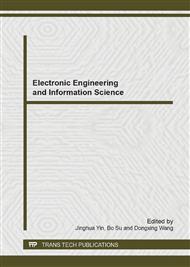p.932
p.936
p.940
p.946
p.951
p.957
p.961
p.966
p.972
The Photocurrent Characteristic Analysis of the Copper Phthalocyanine Organic Thin Film Transistor Irradiated by 700 nm Monochromatic Light
Abstract:
By using organic semiconductor CuPc as photosensitive materials, we prepared an organic thin film transistor with the vertical structure consisted of metal Cu/ organic semiconductor CuPc/ Al/ organic semiconductor CuPc/ indium tin oxide ITO. CuPc semiconductor material has good photosensitive properties in the 700 nm light. When the light signal irradiates organic semiconductor photosensitive material, the electron-hole exciton is separated into photocurrent in built-in electric field produced by organic semiconductor material/ metal schottky contact. It transforms into the driving current of organic photoelectric triode. By using its current amplification effect, the output current increase obviously. The test result shows that the I-V characteristics of the transistor are obvious unsaturated triode characteristics. When using 700 nm light to irradiate the device, the working current of the device increases obviously.
Info:
Periodical:
Pages:
951-954
Citation:
Online since:
July 2014
Authors:
Price:
Сopyright:
© 2014 Trans Tech Publications Ltd. All Rights Reserved
Share:
Citation:


